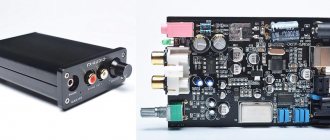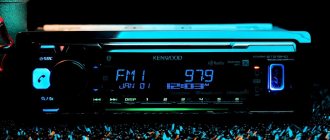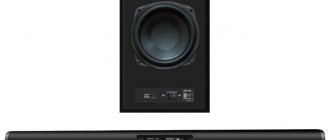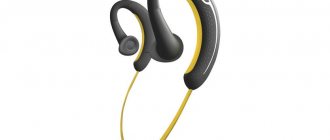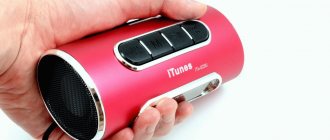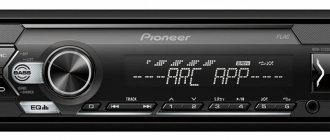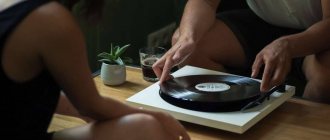not found!
send a request
A sound card (or audio interface) is one of the most important devices for absolutely every modern musician. A sound card is designed to ensure the process of transmitting a sound signal from a computer to headphones or from a microphone/pickup to a computer.
Most modern devices already have a built-in sound card, but built-in solutions do not offer the high performance that is so important to musicians. Built-in sound cards cannot guarantee sound recording at an acceptable level; they have a delay in audio processing. In addition, the built-in interfaces only have standard inputs and outputs for audio equipment (usually a minijack). Therefore, it will be very difficult to record an electric guitar in good quality or vocals using a professional microphone on this sound card.
How to choose an audio interface?
To an unknowing user, sound cards look like incomprehensible boxes with a bunch of inputs and outputs, and therefore it is quite easy to make a mistake when choosing a sound card.
When choosing equipment, you need to answer the following questions:
- Why do you need a sound card?
- What are the specifications of your computer?
- What inputs and outputs do you need?
- How much do you want to pay?
Perhaps we’ll move on to the technical aspects a little later, but for now we suggest considering the issue of price and purpose of the sound card.
What's the price?
For example, you decide to purchase a sound card to play the electric guitar at home - in this case, the simplest sound card with one input for a guitar, an output for headphones/speakers, with a volume control and a Gain level control will suit you.
Prices for the simplest sound cards on the secondary market start from 3,000 - 5,000 rubles, and for the same new ones they ask from 7,000 to 10,000 rubles. Accordingly, the more inputs and outputs a sound card has, the more functionality it has and the more expensive it is.
Sound cards for home recording studio
Studio-grade music equipment often differs dramatically from their home versions, and this is not a surprise. Amplifiers, effects processors, and even musical instruments such as synthesizers are located in special cabinets in a studio environment. This allows you to save space and plan switching correctly and compactly. Such cabinets are called rack racks.
The devices have strictly defined dimensions, are equipped with special runners for fastening and eyes for bolts.
If desired, a rackmount sound card can be kept on the table, but in this case it will take up a lot of space, and this is unlikely to suit you.
Comparison of studio and home sound cards
- Size. The studio sound card is rack-mountable, while the home audio interface can easily fit on your desktop. There's no point in going beyond a compact device until you have a dedicated room for your recording studio.
- Power. Of course, studio devices are much more powerful and productive than their home counterparts. But, to be honest, in most cases you won't need half the power that a professional studio audio card provides. A home audio interface will be enough to record a full song. You're not going to record a whole orchestra in your room, are you? In general, most modern sound cards from well-known brands have good power and sufficient functionality. They are all about equally good. Devices from the brands FOCUSRITE, Steinberg, M-Audio, Roland are the best sound cards for a home recording studio.
- Functional. With the exception of some special features, such as digital data transfer, a World Clock port and built-in DSP effects, home studio sound cards are not inferior to their professional counterparts. Many home models have up to 4 combined inputs, several outputs, connections for monitor speakers and headphones, MIDI input and output. Keep your goals in mind and make your choice.
Tags: sound, reviews Number of impressions: 792
About the device: audio inputs
Most sound card models have two audio inputs. For example, an instrumental input (guitar, synthesizer) and a microphone input, or two instrumental or two microphone inputs.
Professional-level sound cards can have several dozen audio inputs - such cards are most often used as stage or studio equipment.
In other words, one input will allow you to record sound with only one instrument or one microphone.
As an example, we suggest looking at the audio inputs and outputs of one of the most popular sound cards – Focusrite Scarlett Solo 3rd Gen
Front Panel:
Let's look at it from left to right:
- The front panel has a microphone input, a Gain control knob, a phantom power button, and an Air mode button (preamplifier).
- In the center there is an instrument (line) input into which an instrument is connected, a Gain control knob, and an inst (preamplifier) button.
- on the right side there is a volume control, a sound switching button (allows you to choose where the sound comes from - directly from the card or from a sequencer / virtual amplifier) and a headphone output in Jack 6.3 format.
Back panel:
On the rear panel you can see a Kensington lock, two balanced 6.3 mm jack outputs and a Type C port for connecting to a computer.
Interesting fact: two balanced outputs will not allow you to fully use the sound card to turn on the substrates on stage. The problem is that from one output the substrate will go with the metronome to the drummer’s headphones in mono mode, and from the second output the substrate will go to the mixer also in mono mode. Accordingly, the sound will not be surround, and for stereo sound you need 4 balanced outputs (two left and two right).
For comparison, we suggest taking a look at the professional sound card model Focusrite Scarlett 18|20 3rd Gen. The card has 18 inputs and 20 outputs and has enormous capabilities. A sound card of this format is the most important device in any recording studio, its heart.
Front and back view:
There are also very simple sound cards with one input for a guitar and an output for headphones (Line 6 Studio GX):
At this stage, we should conclude that there are sound cards on the market for absolutely everyone - for beginners, for amateurs, and for professionals. The most important thing to consider when choosing a sound card is your goal. For example, the above-mentioned Line 6 Studio GX is perfect for playing an electric guitar through a computer, but for recording sound it is better to consider Focusrite.
Then the question arises: why do you need more than two inputs if you plan to use a sound card at home?
The answer is quite simple: the more inputs, the more recording methods available to you. For example, an instrument input and a microphone input will allow you to record a guitar, capturing the sound from both the pickup and the amplifier using a microphone. Two microphones located in front of the vocalist and two meters from him will make the recording deeper and more “alive”. In general, a free field for creativity. Recording a choir or live recording a rock band playing is a different story.
Studio sound card – what to look for when choosing
A studio audio interface (sound card for a recording studio) solves complex problems of processing sound from an analog signal to a digital signal and vice versa. It must be powerful enough to handle multiple incoming and outgoing signals at once. Let's look at the available connectors and switching, as well as functionality.
Digital and analogue connectors
Unlike sound cards for home recording studios, studio audio interfaces support multiple analog inputs simultaneously, which allows you to record multiple instruments and multiple vocalists at high frequencies (usually 192 kHz/24-bit). Such devices can transmit the entire signal via digital outputs ADAT, S/PDIF, to which optical cables are connected.
Thus, several stereo signals can be transmitted at once using one high-speed cable, which greatly simplifies switching and helps increase operating speed.
In addition, studio sound cards can be connected to each other, forming a chain of devices. That is, you can expand the functionality and carry out even more operations for recording, processing and listening to sound.
MIDI in/out
Also, MIDI connectors are required. They are necessary for connecting musical instruments, such as synthesizers and drum machines, and are needed to exchange data between the instrument and the sequencer. Roughly speaking, you can write the notes that the synthesizer should play into a digital sequencer on the computer, and using a MIDI connection, the computer will tell the instrument what to play. In the same way, you can record notes played on a synthesizer into a sequencer. The number of MIDI connectors on a sound card is usually from two to four.
World Clock connector
Interesting things begin to happen when you can count a dozen units in a chain of connected and simultaneously operating digital devices. Each such device has its own clock frequency, and the internal elements adapt to it in order to provide data without delay.
But even the most accurate device will have an error, because the processor crystal cannot always be made the same, and different devices will lag behind each other. To bring all digital devices in the studio to a common denominator and synchronize, there is a special metronome that produces pulses of a certain frequency. A sound card for a recording studio, as well as other studio machines, is connected to it using the World Clock connector.
In addition, one of the devices, for example a sound card, can be assigned as such a metronome, and other devices can be synchronized with it. For this purpose, sound cards have a World Clock Out connector.
Headphone and monitor connectors
On the front panel of the device, two headphone jacks are usually placed so that the sound engineer and musician can simultaneously hear the signal entering the audio card, be it the sound of an electric guitar, vocals, or another instrument. Hearing and monitoring what is happening is very important for writing music, otherwise it is simply impossible to work.
Of course, you can also connect monitoring speakers using a balanced silent cable to the sound card.
DSP effects processor
Advanced studio audio interfaces have a built-in effects processor that can be used to process the signal. That is, you can not overload the computer with processing, but give this task to the sound card. Here you will find all the standard effects, such as reverb, delay, flanger, phaser, as well as a compressor, limiter, etc.
Preamplifiers
To enrich the recorded signal from microphones, many sound cards in the recording studio have built-in preamps that saturate the incoming signal with harmonics, and also recreate the characteristics of the sound passing through classic preamps, for example, from brands such as Universal Audio, API and Neve. This simply decorates the sound, making it lively and spacious.
Audio outputs
We've already looked at audio outputs earlier, but the example we gave is just a drop in the ocean of sound cards.
For example, sound cards can be equipped with the following types of outputs:
The only thing you need to pay attention to is the presence of a line output to which headphones, speakers or monitors are connected.
In simple words, you should ask yourself the question: “ What will I connect to the sound card?
" The answer to this will simplify the choice of sound card.
Interesting fact: there are various adapters from one connector to another, which will allow you to unify some connectors.
For example, Jack 6.35 on XLR or Jack 6.35 on RCA .
Connecting a sound card and equipment
Most modern computers (PC and MAC) can easily connect external sound cards. You just have to take into account that some computers do not have the appropriate port, and therefore you need to purchase the appropriate adapter.
It is also worth considering the issue of driver compatibility. What if this or that device does not work on your operating system? This problem is relevant if you have an old device. Specifically, an old Apple device. All modern computers easily detect new equipment and can work with it.
Creative Sound Blaster Play! 4
- Location: external
- Sound card format: 2.0
- Connection interface: USB Type-C
- ASIO support: no
- DAC bit size: 24 bit
- Maximum sampling rate: 192 kHz
- Signal to noise ratio: 110 dB
- Supported headphone impedance: 16-150 ohms
- Microphone phantom power: no
- Connectors: 1*mini-jack 3.5 mm
I'll start with an entry-level budget sound card - Creative Sound Blaster Play! 4. The device is connected via a USB Type-C connector. If this is not available, then you can use the adapter to Type-A, which is included in the package. The model is compatible with both Windows and MacOS computers, as well as smartphones, tablets and game consoles from Sony or Nintendo, although with some restrictions: Creative proprietary software only works on Windows.
Despite its compact dimensions and not the most top-end specifications, this sound card can greatly improve the perception of audio content, bypassing any built-ins from the so-called Realtek. Headphones with a resistance of up to 150 Ohms will open up to their full potential.
Creative's proprietary software provides various features for voice communication. Such as Voice Detect technology, which recognizes voices and automatically turns the microphone on/off during a call, and two-way noise reduction “Noise Clean”. You can see how it all works on the manufacturer’s website. Well, it’s also worth noting the second button on the device, which is responsible for activating one of two preset sound modes: Dynamic and Bass Boost. If the LED glows white, then the first mode is active, and if it glows blue, then the second. If there is no light, then neither of these two equalizers is activated.
Sound quality
The better and higher quality the sound card, the more expensive it is. You have to pay for quality, and therefore we advise you to consider well-known and trusted manufacturers (Line 6, Focusrite, BEHRINGER, M-Audio, etc.).
If you're on a budget, consider purchasing the card secondhand. When purchasing, you should pay attention to the functionality of all inputs, outputs, regulators and switches. There should be no background noise from the sound card when turning the controls (especially the volume control). Appearance, as a rule, does not play a special role.

